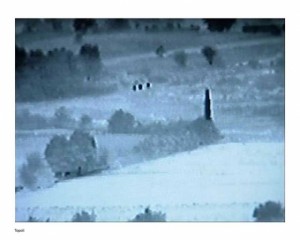Nika Autor and Rena Rädle & Vladan Jeremić
diskussion Between Worlds
Monday, November, 2013 at 19:30
Galerija Miroslav Kraljević
participants: Nika Autor, Rena Rädle & Vladan Jeremić, artists, Iva Marčetić, architect and member of the Young Anti-Fascists of Zagreb, Nikola Vukobratović, member of the editorial board of the Croatian edition of Le Monde Diplomatique and [BLOK]
Discussion Between Worlds is accompanying program of the exhibition Between Worlds II which approaches the issue of migration in the contemporary economic and political moment from the position of the criticism of the production and use of images, but also a step toward broadening the questions that the exhibition opens by the contribution of invited interpretators. Participants in the discussion, beside artists and curators, are experts who talk about reasons and broader implications of migrations, as the question of right to the housing or question of mobility in the art field, each time starting from the analysis of the exhibited works.
NIKA AUTOR
Postcards
experimental film, 9′, 2010
The footage was taken from the archives of Radio-Television Slovenia. It represents a collection of the archival documentation on media reports on migration from 2001 to 2008. I was interested in analyzing the representation of asylum seekers as constructed by the dominant discourse, that is, the institution, whose function is to shape images and thought. I wanted to show how images as such, through the way they are produced, effect the criminalization and victimization of asylum seekers, refugees, migrants… Images of shapless and nameless people not only victimize or criminalize, they produce specific lives as Other.
This film is the first part of the diptych Postcards and Report on the situation of asylum seekers in Republic of Slovenia, January 2008 – August 2009.
Impressions: Landscapes/Paradise of Slovenia
photo series, 2011
These photos are based on the recordings from the video archives of RTV Slovenia. They show Slovenian landscapes captured by thermographic cameras used for territory surveillance. Based on thermal differentiation, these cameras produce new images of the living which presents itself as illicit, as something that disrupts the ideal dullness of the landscape. The violence which is inscribed into the visible is manifested in the mode of production of these images, the montage, and the presentation of the material in the media. TV news which showed the recordings hid, patched and smoothed over the gaps that were created in representation during the process of montage. Images thus became a source of interference that needs to be removed. For the thermographic camera, human outlines are a disturbance, they deface the Slovenian landscape. To cleanse the image of disturbances, to cleanse the “Slovenian” landscape.
And what do police photography and Grohar’s Spring (Poletje) have in common? The subject of the landscape, prevalent among Slovenian impressionists, acquired an aura of national painting by its entry into the national canon. The landscape of Slovenia, “painted over” in such a way, thus becomes a “mental image of homeland landscape,” and this is the desire of the hot lens that flattens the image so we can stage Spring once again.
Nika Autor works in the field of contemporary art practices. The topic of her artistic interest is the relationship between the artist and his or her immediate surroundings.
RENA RAEDLE & VLADAN JEREMIĆ
The Housing Question
installation with videos and a drawing, 2013
The installation The Housing Question depicts the reality of Roma and other precarious migrant workers through three case studies, in three different European cities, Belgrade, Helsinki and Rome, and tries to critically reflect on the issue of accumulation achieved through expropriation in neoliberalism and expose the connection of these processes to racism. One of the videos that are integrated into the installation, Belleville, is a product of the protest of Romani families following their forced eviction and demolition of their houses by the city government and for the sake of construction works related to the sports manifestation Universiade 2009 in Belgrade.
After similar forced resettling and demolition of a Romani settlement in Helsinki in 2011, Rädle & Jeremić invite activists, politicians and theorists to participate in a public discussion about the possibility of building a trans-urban network of “hotels for precarious workers” in European cities as well as a series of proposals for the establishment of uniform principles for local housing solutions which would be realized in Helsinki and elsewhere in Europe. The video The Housing Agenda presents the main principles regarding the given issue.
In order to unmask the models of market-oriented welfare and the commercialization of public services to the European precarious class who is denied the right to urban living, Rädle & Jeremić point to the perfidious system developed in the city of Rome, where Roma are housed in ghettoized container settlements and monitored by security guards. The animation The Housing Question incorporates animated drawings of the city of Rome and the speech of three characters: an elderly woman who survived a concentration camp in Germany and two younger male characters who live in contemporary ghettoized settlements in Rome. The animation emphasizes the continuity of European racist policies towards Roma, situating their speech in the familiar historical setting of the city or places in Rome such as Casilina 700 and 900 where settlements have been demolished and their inhabitants relocated to containers.
Rena Rädle & Vladan Jeremić are artists from Belgrade, cultural and political workers who do interventions and documentary videos, photo collages and drawings. They have been working together since 2002. The focus of their research is the political economy of the city and social struggles in the context of the production of city space. Their projects “Under the Bridge”, “The Housing Agenda”, “On the Use Value of Art”, “Belleville” and “Gazelle” support Romani movements and those of other precarious workers in Europe with the aim of strengthening the potential for the transformation of society.
